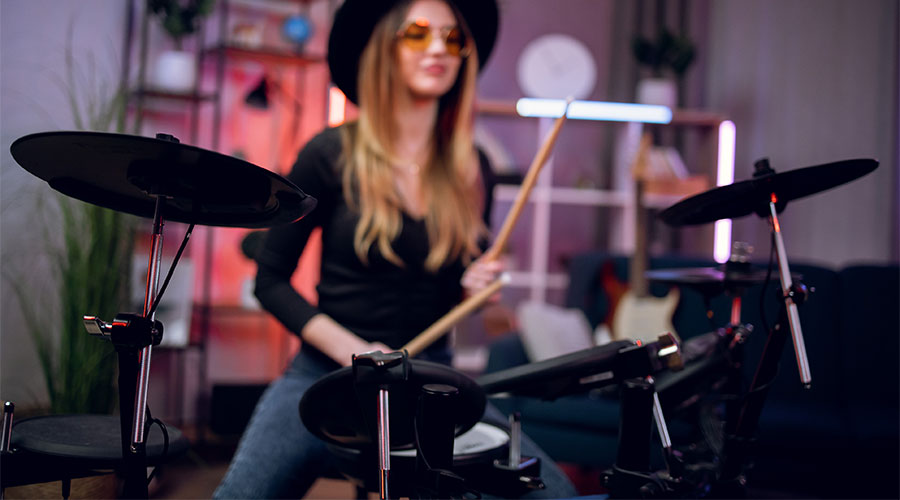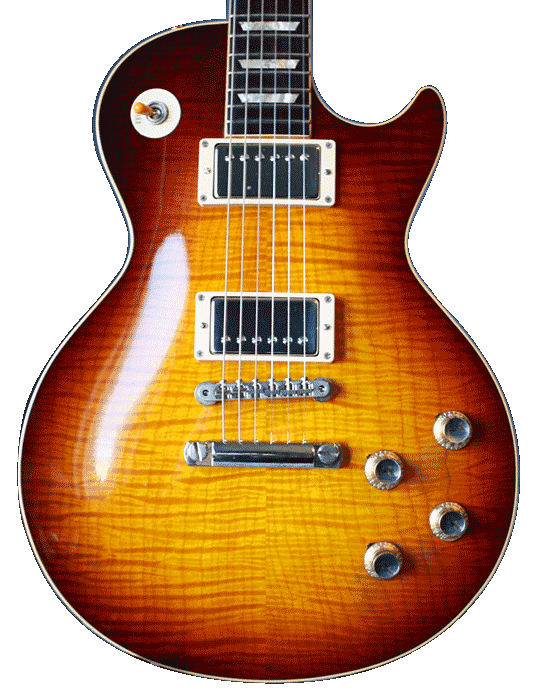
Electronic drums have always been seen as a quieter alternative to acoustic kits, but did you know that they’re more popular in 2025 than they’ve ever been before?
More and more drummers are starting their playing journeys on electric kits due to them often being more affordable and accessible in the beginner product ranges. You’ll still get a bit of resistance from drummers who say acoustic drums are the only answer, though.
How true is that, and has electronic drum kit technology reached a point where most people finally back the kits? Here’s everything you need to know.
How Electronic Drums Work
Electronic drums consist of three main components, which are drum pads, cymbal pads, and a drum module. Those pads connect to the module via cables, and they’re assembled on a plastic or metal rack to imitate the setup of an acoustic drum kit.
Some electronic kits have rubber pads, but most have mesh or silicone pads that closely resemble the stick response you get from acoustic drumheads. You can also tighten them to change that response.
All cymbal pads are rubber, but some have better designs than others.
These drum and cymbal pads have trigger zones. When you strike them, they send a signal to the drum module to produce sounds connected to those zones.
The number of trigger zones you get depends on the quality of the electronic kit you’re playing. Inexpensive kits have fewer zones, while pricier kits have more zones to give better playability.
The drum module is the center of every electronic drum set, as it provides the sounds and features. All drum modules have a set number of preset drum kit sounds to use, and some allow you to create your own drum kits with provided sounds.
Drum modules also have features such as play-along tracks, sound editing tools, and coaching functions.
You use the same kick pedals, drum throne, and drumsticks for electronic drums that you do with acoustic drums.
Electronic Drum Kit Origins
Electronic drums were all the rage in the 1970s. The first kit was created by Graeme Edge and Brian Groves. It was a personal project between the two, and Graeme Edge used it in a Moody Blues song called Procession.
Pollard Industries released a commercial electronic kit called the Pollard Syndrum in 1976. While many drummers loved the idea, it didn’t sell.
Eventually, Simmons was created as a dedicated electronic drum kit brand in 1978, and that’s when the popularity of e-kits kicked off.
Pop and rock drummers were using the famous hexagonal Simmons pads in their setups, and the sampled electronic sounds became a staple in a lot of 70s and 80s music.
The popularity of Simmons kits died down in the late 80s, along with the frequent use of electronic kits in popular music.
Since then, Roland and Yamaha have been the big electronic drum kit brands.
Do Electronic Drums Sound Like Real Drums?
It depends on the make and model you’re looking at. All electronic drum kits are designed with samples that sound like real drums, but the quality of those samples differs across price ranges.
Cheaper electronic drums tend to sound more robotic than higher-priced ones.
A big reason for this is that higher-quality kits have better dynamic control. Their pads and cymbals respond more realistically to the way you hit them. If you hit a snare hard, it will produce a loud and punchy sound. Hit it softly, and you’ll get a light sound.
With cheaper electronic kits, you don’t get as much of a difference between those dynamic levels, leading to drum kit sounds that sound more electronic than anything.
Brands like Roland create their samples from scratch, so they tend to sound better even with the cheaper models. Brands like Yamaha use recorded samples from acoustic kits, so the cheap kits with less playability always sound worse.
So, high-end electronic drums can easily be used for professional gigs. Cheaper drum kits will stand out because of their poor sound quality.
How to Hear What You’re Playing on Electronic Drums
You need to either have a speaker or headphones to hear what you’re playing on an electronic drum kit.
Every drum module has two output ports – one for headphones and one for a 3.5mm jack. The headphone port will be for a small jack, and you can plug any earphones or headphones into it to hear what you’re playing.
The larger port will be for a speaker or amp that uses a big jack. If you don’t have a speaker or headphones, you won’t be able to hear anything, as no drum module comes with a built-in speaker, like you often get with keyboards.
It’s great to play drums with headphones on for sound reduction reasons, but most drummers recommend having an amp to go with an electronic kit so that other people can hear what you’re playing.
Electronic Drums as a Beginner Option
There are pros and cons for beginners who want to use an electronic drum kit.
One of the advantages of e-kits is that they always come with all the drums and cymbals you need. Most high-quality drum kits only come with shells when you buy them, meaning you need to buy cymbals and hardware separately.
With electronic kits, you get all the cymbals and hardware with a single purchase, often saving you a lot of cash.
Drum modules always offer a fun range of sounds to try out, and that keeps many beginner drummers interested. They also don’t need to worry about tuning the drums, which is a skill in itself.
The big downside is that beginner drummers don’t get to develop several techniques needed to play an acoustic drum kit. There are ways to hit real drums that don’t give you good sounds, but an electronic kit won’t teach you what those are.
Electronic kits also have more rebound than acoustic drums, so you may feel like you play a lot worse when you sit at an acoustic kit.
The best thing to do is play on both when you’re learning. Playing an acoustic kit is still mostly what drumming is all about, so it’s vital for a beginner to get experience with playing on one.
Electronic Drum Kit Prices
Electronic kits have a strong reputation for being very pricy, but it depends on what tier you look at. You should know that there are dozens of good drum kits costing less than $1000, and they’re all incredible options for beginner drummers.
The reputation for electronic kits being expensive has slowly improved over the years, with brands like Alesis and Behringer specializing in creating affordable options.
It’s the Yamaha and Roland kits that are expensive, and those are the ones that experienced drummers love the most due to their sound quality and playability being much better.
These kits are expensive because the technology used makes them cost a lot to create. High-end electronic kits have the best durability, and their drum modules are packed with intuitive features that boost them a class above all the competition.
It also has something to do with their market value. Roland kits are still considered the best in terms of quality that you can possibly get, so buyers are willing to pay for them. That stops Roland from needing to drop prices.
With that being said, a $3000 electronic drum set will offer you far more sounds and features than a $3000 acoustic drum set. Many people think the price is worth it because of that.
Electronic Drum Kit Playability Compared to Acoustic Drums
Electronic drums are far more forgiving on your hands than acoustic drums, and that makes many drummers find them easier to play.
You also don’t need to hit any drum or cymbal in the sweet spot to get the best sound possible. No matter where you hit the pads, you’ll always get the best sounds from the drum module.
Mesh and rubber pads offer more rebound than acoustic drumheads, so it’s easier to play quick patterns on e-kits.
It’s common for experienced drummers to sit at an electronic kit and pull off patterns that they normally wouldn’t be able to play cleanly on acoustic drums.
This isn’t the case for everyone, though. Electronic drums are smaller than regular drum kits, and some drummers find them a lot harder to play due to the size difference.
How Long Do Electronic Drums Last?
It depends on what brand of electronic drums you have. Roland, Yamaha, and Pearl e-kits are known to last much longer than any others. Roland drum kits, in particular, are always stated to be the most durable electronic drum kits in the music world.
There are countless drummers still using Roland drum kits that they bought ten or more years ago. The brand has excellent quality control, so finding replacement parts is easy.
Kits from brands like Alesis and Behringer don’t last as long. While these kits are attractive with their low price tags, it only takes a few years before bass drum triggers and hi-hat pedals stop working properly.
You’ll mostly find that with the lower-priced models, as the intermediate and professional kits from Alesis are fantastic.
However, technology is constantly improving, so electronic kits are regularly being discontinued every year. This means that no electronic kit will ever last as long as an acoustic kit will. Drummers who primarily play electronic kits tend to buy better ones every four to six years.
Acoustic kits will last a lifetime if taken care of properly.
Embracing the Future: The Rise of Electronic Drums in Modern Music
The evolution of electronic drum kits from the 70s until now is amazing to see. It’s reached a point where brands are designing e-kits with acoustic shells so that they look and feel like acoustic kits.
A last thing to mention about electronic drum kits is that it’s a good idea to view them as additional instruments and not replacement ones for acoustic kits. There are so many things you can do with a drum module that aren’t possible on acoustic drums.
That’s why a lot of professional drummers own both. They use their e-kits to practice, but they also use them to record electronic drum parts with various synthetic sounds.
Share your thoughts in our forum! 💬
👉 Introduce yourself and show off your drums and other gear.
Frequently Asked Questions
What is the difference between electric drums and normal drums?
Acoustic drums produce sounds through vibrations, whereas electronic drums produce sounds through triggers and technology. Acoustic drums can be played at any point, but electronic drums need to be plugged in to be heard.
Are electronic drums better than regular drums?
For the most part, no, most electronic drums still don’t live up to the responsive playability that you get from acoustic drums. However, pro-level electronic drums are much better than beginner acoustic drums.
Do electronic drums make noise?
They make far less noise than acoustic drums, but you can still struggle with noise issues when playing an electronic set. The mesh and rubber pads can still be heard when you’re playing with headphones on, and the vibrations from the bass drum pad will travel through the floor. Some people can’t use electronic drums in apartment buildings because of that.
What do electronic drums do?
Electronic drums are designed to emulate the playing experience you get when using acoustic drums. Everything is powered electronically through triggers and samples, and you can play electronic sounds that aren’t possible to achieve with an acoustic set.
Share this post with your friends using these one-click sharing options:
👉 Click here to share on Facebook.
👉 Click here to share on X.
👉 Click here to share on LinkedIn.

Get the latest reviews, guides and videos in your inbox.